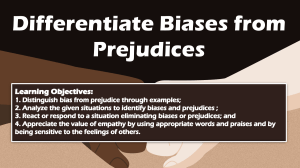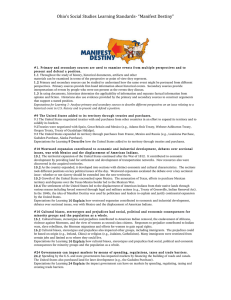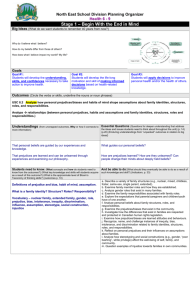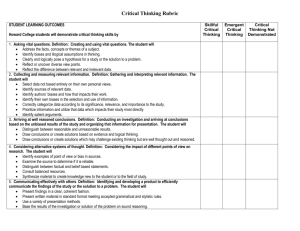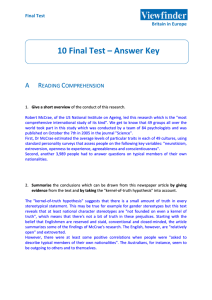Reading Literary Texts Rubric
advertisement
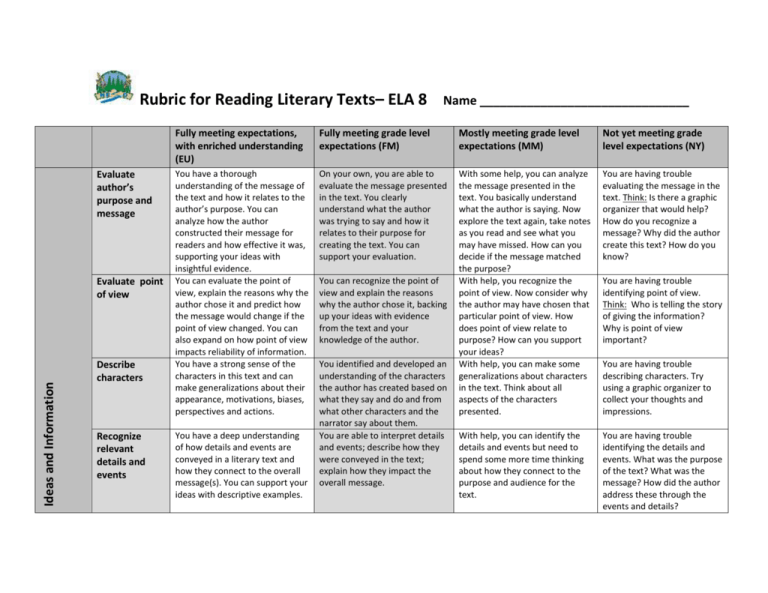
Rubric for Reading Literary Texts– ELA 8 Evaluate author’s purpose and message Ideas and Information Evaluate point of view Describe characters Recognize relevant details and events Name _______________________________ Fully meeting expectations, with enriched understanding (EU) Fully meeting grade level expectations (FM) Mostly meeting grade level expectations (MM) Not yet meeting grade level expectations (NY) You have a thorough understanding of the message of the text and how it relates to the author’s purpose. You can analyze how the author constructed their message for readers and how effective it was, supporting your ideas with insightful evidence. You can evaluate the point of view, explain the reasons why the author chose it and predict how the message would change if the point of view changed. You can also expand on how point of view impacts reliability of information. You have a strong sense of the characters in this text and can make generalizations about their appearance, motivations, biases, perspectives and actions. On your own, you are able to evaluate the message presented in the text. You clearly understand what the author was trying to say and how it relates to their purpose for creating the text. You can support your evaluation. With some help, you can analyze the message presented in the text. You basically understand what the author is saying. Now explore the text again, take notes as you read and see what you may have missed. How can you decide if the message matched the purpose? With help, you recognize the point of view. Now consider why the author may have chosen that particular point of view. How does point of view relate to purpose? How can you support your ideas? With help, you can make some generalizations about characters in the text. Think about all aspects of the characters presented. You are having trouble evaluating the message in the text. Think: Is there a graphic organizer that would help? How do you recognize a message? Why did the author create this text? How do you know? With help, you can identify the details and events but need to spend some more time thinking about how they connect to the purpose and audience for the text. You are having trouble identifying the details and events. What was the purpose of the text? What was the message? How did the author address these through the events and details? You have a deep understanding of how details and events are conveyed in a literary text and how they connect to the overall message(s). You can support your ideas with descriptive examples. You can recognize the point of view and explain the reasons why the author chose it, backing up your ideas with evidence from the text and your knowledge of the author. You identified and developed an understanding of the characters the author has created based on what they say and do and from what other characters and the narrator say about them. You are able to interpret details and events; describe how they were conveyed in the text; explain how they impact the overall message. You are having trouble identifying point of view. Think: Who is telling the story of giving the information? Why is point of view important? You are having trouble describing characters. Try using a graphic organizer to collect your thoughts and impressions. Respond to and analyze texts Text structures and features Evaluate author’s craft Identify structures, features, elements and techniques of text from Recognize values, biases, stereotypes and/or prejudices Feedback: You are able to evaluate the effectiveness of a range of written texts including insightful reflection on the craft. You support your personal and critical responses with specific and relevant references to the text itself. You are able to imagine solutions or alternatives to aspects of the text craft. You easily recognize and deeply analyze text structures, elements and techniques and how these contribute to the intended message of the text. You are able to draw comparisons to other texts and evaluate their effectiveness. You not only recognize the values, biases, stereotypes and prejudices present in the text but can analyze how they impact various viewers and the message itself. You can offer possible impacts of the author’s life experiences on the choices they made in the text. You are able to evaluate the effectiveness of a range of written texts including reflecting on the craft. You support your personal and critical responses with references to the text itself. With help, you can evaluate the effectiveness of some aspects of a text. Think about craft when offering an evaluation and really work on supporting your opinions with references to the text itself. You are having trouble evaluating the effectiveness of a text. Think: How can I evaluate the craft of the author? Where do I look for ideas and support for my opinions? You recognize and analyze text structures, elements and techniques and how these contribute to the intended message of the text. With help you recognize and analyze some text structures, elements and techniques and how these contribute to the intended message of the text. Think deeply about how various texts are structured to suit the purpose. With some guidance, you can recognize some of the values, biases, stereotypes and prejudices present in the text. Look for less obvious examples. Talking about the text with someone else might help you identify aspects you hadn’t considered. You need much help to recognize and analyze text structures, elements and techniques and how these contribute to the intended message of the text. Refer back to examples done in class. You are having trouble identifying values, biases, stereotypes and prejudices. Ensure you understand what these terms mean and brainstorm examples to help you become more confident in identifying them. You identify how the author’s experiences, background and culture affected their message. You can describe values, biases, stereotypes and/or prejudices present in the text.
